It is no secret that today gas stoves for the kitchen are no longer the most popular. In use for a long time electrical and induction hobs... Yes, most often they are more expensive and require special care; nevertheless, many housewives opt for more modern technology. Well, for cleaning and washing the surfaces of advanced kitchen stoves, there have long been special compositions. So, the editors of the site "bestx.htgetrid.com/en/" bring to your attention the TOP-7 best cleaners for glass ceramics.
The evolution of cookers
Like any modern technology, the kitchen stove has gone through a rather difficult but interesting development path. It all started from far away from us, when the stove was still called a stove.
Early times

The first ovens, according to historical data, were built in pre-dug pits. There was, in fact, a fire, and above the pit there were various kinds of devices, akin to spits. They cooked food on them. The next stage of development is considered to be the improvement of this pit. This was done in approximately the following way: the walls were first tamped, then covered with clay and then covered with stones. Thanks to this device, the oven retained heat longer.
The time has come when they began to transfer stoves to homes. However, initially this "furniture" served as the cause of frequent respiratory tract poisoning for the owners living there. The reason for this was the lack of chimneys. Accordingly, all the smoke, all the fumes were inside the room. And only around the 12th century, the world began to install stoves with chimneys.
The oven becomes kitchen
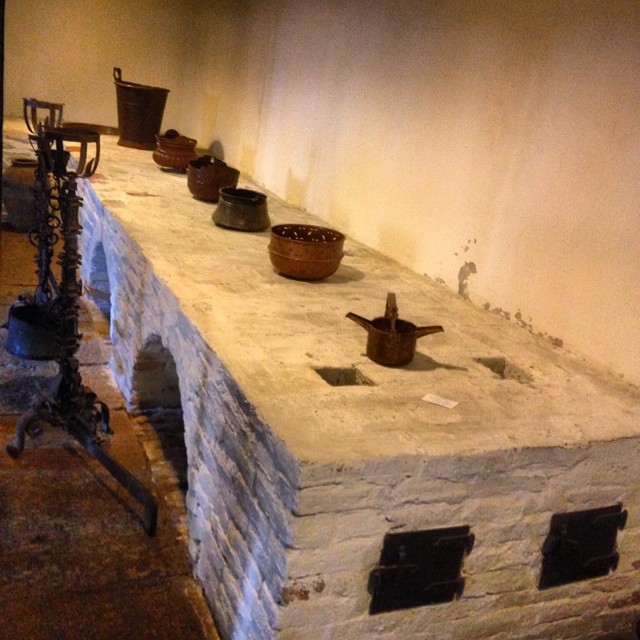
By the way, the first appearance of stoves with chimneys is associated with large locks. There, their use was functionally extended, that is, they were used not only for cooking, but also for heating the room. Just like in the Soviet "Khrushchev" buildings on harsh winter days.
However, over time, many noble people ceased to arrange such an alignment. The solution was to move the stoves to the kitchens (dining rooms). Medieval household appliances were a stone structure with a lid made of a stone or cast iron slab and, of course, a chimney.
However, in smaller buildings, the stoves continued to combine two functions: kitchen and heating. A striking example of this is Russian huts. Moreover, in Russia, stoves were often used as sleeping places. Especially in severe cold.
Even today, you can find the so-called mother stove in remote villages, where there is still no gas supply (and somewhere electricity supply).
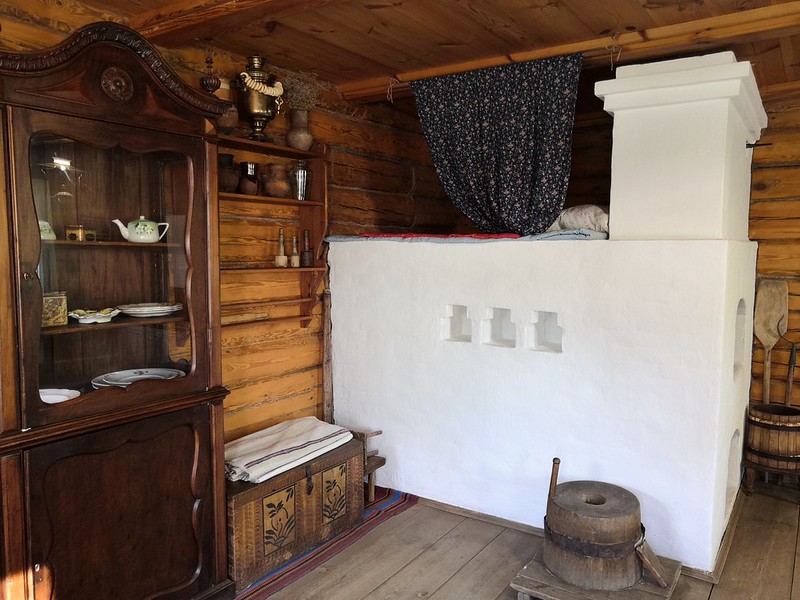
Dutch ovens
Well, with Russia, everything is more or less clear: the abundance of forests, respectively, and fuel for the stoves. But what about Europe, in which there are not so many "wooden" resources?
The Dutch gracefully found a way out of this situation:
- Firstly, instead of the usual stone, they began to use cast iron as a material for the furnace. It heated up much faster and took longer to cool.
- Secondly, the stove was faced with tiles and tiles, pursuing the same goal - to reduce heat loss.
- Third, the wood was replaced with coal.
In honor of their inventors, these ovens were named "Dutch", which quickly spread across Europe.
Late XVII - late XIX
By 1800, heating stoves were already compact and practical: they were made of cast iron and fired with coal. But the kitchen colleagues received the same advantages only at the end of the 17th century. "Rumford" was born and a little later "Rangemaster". The latter, by the way, only had dimensions larger than modern slabs.
The "Rangemaster" functionality was supplemented with water heating (there was a separate boiler) for technical work around the house. One hotplate has been provided for basic cooking. However, this was not enough. Nevertheless, the increase in the number of burners to the usual four occurred only towards the end of the 19th century. By that time, slabs were becoming more and more affordable: both in price and in size. The material for the body was steel painted with enamel.
Another significant date is 1826. It was then that a gas-powered kitchen stove was first used. Of course, the term of operation was extremely short, but the fact that the stove worked on "blue fuel" and was quietly placed in the apartment already speaks volumes.
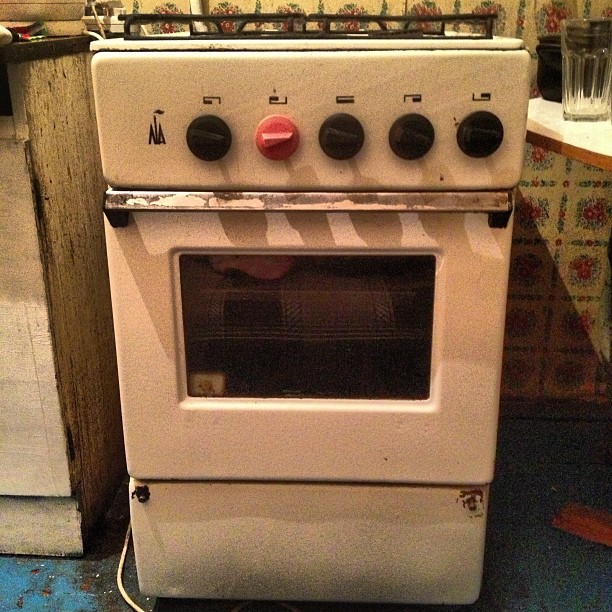
1900s - today
Soon the time will come for electric cookers. The first of its "family" is associated with the name of Thomas Ahern. Its development was slightly improved after Emil Ratnau, founder of AEG. He also managed to ensure that the plate became widespread.
It all started with engineers in 1908. Then Ratnau convened a whole group of specialists to develop a new, modified and full-fledged electric stove. As a result, I saw the light of the technique, the burners of which were heated for more than half an hour. Coupled with the high price, the device seemed to be completely out of demand. In reality, everything happened exactly the opposite: nothing scared people away, everyone wanted a new "toy" for their kitchen.
Meanwhile, gas stoves for the home were actively sold in the New World. They worked from a balloon, which was convenient on the one hand, but on the other, they were very dangerous. The fact is that many housewives did not know how to use and did not follow safety precautions, which is why accidents were quite frequent.
In 1945, another significant event took place - the invention of the microwave. Percy Spencer came up with a new way of cooking - using electromagnetic waves. Perhaps, if it were not for the well-established centralized gas supply in the post-war years, the advantages of the microwave would have outweighed the advantages of the then gas models.
The popularity of gas-fueled models was higher (due to the low average price for this natural resource) than electric ones. This continued until the appearance of glass ceramics. Rather, before the start of its use in kitchen appliances. Finally, the panel is smooth without protrusions. Electric stoves have provided themselves not only with accelerated heating of the burners, convenient and efficient operation, but also with greater safety.
And the most advanced technologies in the production of cookers are induction hobs. The hobs themselves come in the same sizes as the electric ones (50x50 cm, 60x60, etc.). But the hotplates are different. Induction has many advantages over electrical. For example: they heat up in a matter of seconds (there are also models with the function of transferring "energy" from one burner to another for even faster heating), consume little energy, etc. In general, higher technical characteristics. Of course, there are also disadvantages: high cost, you definitely need special dishes and a special cleaning agent.
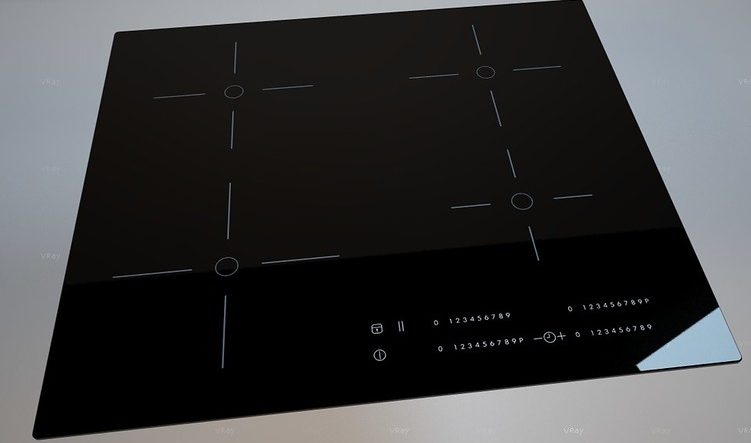
TOP 7 best glass ceramic cleaners for 2020
The best manufacturers offer a wide variety of home appliances for the kitchen: a different number of burners, a different combination (for example, half electric and half inductive), different shapes, functions, and much more. Nevertheless, even the most expensive slabs need care.Among electric and induction hobs, the most common coating is glass ceramic.
For glass-ceramic surfaces there is an important condition - they must not be scratched, because if damaged, the normal functioning of the hob may be impaired. And on top of that, stubborn dirt accumulates in small scratches. At the same time, the cleaning liquid must be strong enough to wash away any burnt oil, milk or other food droplets. Most often, there are either gels or sprays. But sometimes you can stumble upon products in the form of powder, paste or even a pencil.
Still, more confidence is caused by a liquid or slightly thick consistency. The liquid will certainly not leave scratches, therefore, manufacturers make the best own products in a similar state of aggregation.
It is also important to understand how to clean and how to clean the stove. Fortunately, you can read about this in the instructions. Considering these and some other indicators, we present you with the TOP-7 rating of the best glass ceramic cleaners for 2020.
7th place - Bagi Shumanite for glass ceramics
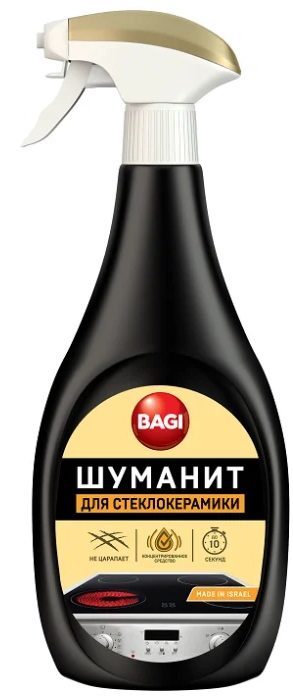
Our rating of quality products for glass-ceramic surfaces opens - Bagi Shumanit.
Bagi Shumanit offers a whole line of products for cleaning kitchen surfaces (and not only). But we are primarily interested in the composition for glass ceramics. Its volume is 500 ml. This is decent compared to many other chemicals. The difference is that other products are concentrated, while Shumanit is not. However, the consumption is not much higher than that of concentrates.
Shumanit is produced in the form of a spray. And the spray, as you know, is more convenient to apply to the surface than a gel or cream. As for the "abilities" of household chemicals from Bagi, most of all it skillfully copes with grease stains, although it will also clean everything else.
Shumanit's description would not be complete without one caveat. Yes, the cleaner is very effective, but all this is achieved due to the caustic composition. Therefore, you should strictly follow the recommendations of the instructions and safety precautions.
Benefits:
- High efficiency in the process of surface cleaning;
- Economical consumption.
Disadvantages:
- For an electric stove with glass ceramics, you must use it very carefully, since the composition is very caustic;
- Accordingly, it is caustic for the skin, therefore, you must strictly follow the instructions;
- Strong unpleasant odor;
- It is impossible to work without the individual protection of the body.
Output:
In favor of Shumanit, his publicity plays. And the question does not even arise about where you can buy it. However, according to some buyers, over time, after using this spray on the hob, blue spots appear on it, which cannot be removed later. Therefore, only 7th place.
6th place - Sanita for glass ceramics
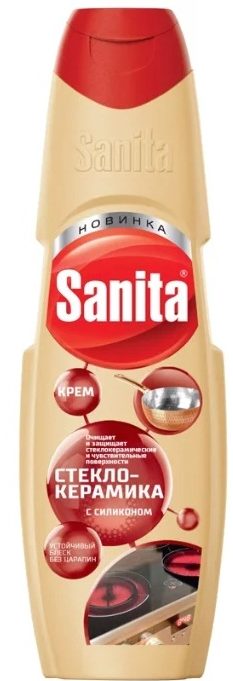
The review continues with the most affordable cleaner in our rating - Sanita. The budget composition sometimes does no worse than the more expensive types. But this applies only to those pollution that is about to appear. If we talk about advice, then Sanita is best used together with a scraper. Sanita will not be able to compete with the established stains and dirt, do not even try. However, these household chemicals can be classified as popular models. Due to its price, it is often purchased and used.
Benefits:
- Very low price;
- Tolerant odor;
- Large volume is enough for a long time;
- Deals well with fresh dirt.
Disadvantages:
- Weak;
- Contains plastic abrasives;
- Ineffective for stubborn stains.
Output:
Just because of the price, Sanita ranks so high.
5th place - Topperr for glass ceramics
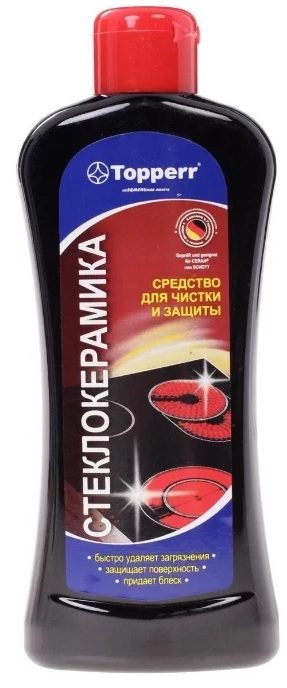
We continue our way to the top and in 5th place is the Topperr company, which is also widely represented in the household chemicals market. Glass ceramic gel from the aforementioned company looks like thick white milk. The detergent acts like all the others: it is applied to the cooled surface for 5 minutes.Then, with the help of a sponge, the dirt is cleaned, and at the end everything is washed off with water or wet wipes.
The Topperr product is a budget product. The set can also be called inexpensive. In addition to the cleaner itself, the package also includes a scraper and a special napkin.
Benefits:
- Affordable price;
- Neutral odor (which is rare among stove products);
- Copes well with simple dirt;
- Contains silicone.
Disadvantages:
- Does not cope with heavy dirt.
Output:
Not a bad tool, but if the selection criterion for you is the removal of completely different contaminants, then it is better to purchase something else. And so, in particular, for a neutral smell we give 5th place.
4th place - Top House
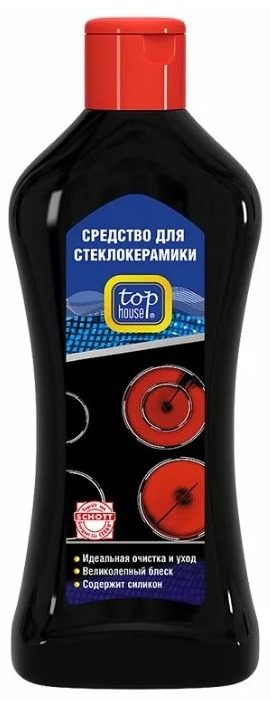
The Top House cleaner came closest to the top three. This hob cleaner is very popular especially in online stores. However, reviews on this tool are too contradictory: from "I buy only it" to "a useless tool that does not cope with anything." But I would like to say that Top House deserves your attention. No wonder it is so high in the rating.
Particularly effective in removing grease and other stains can be achieved with a scraper. Moreover, the tool and the scraper are often sold in a set. Accordingly, it turns out to be more profitable than if you purchase everything separately. But the blade (or knife, if you like) is very quickly exposed to rust. This is due to the poor processing of the blades.
Unfortunately, Top House takes great pains to clean up the tough, stubborn fumes. And sometimes it doesn't cleanse at all.
Benefits:
- Together with a scraper, it cleans well the dirt of medium complexity;
- It is beneficial if purchased as a set;
- Contains silicone, which has a beneficial effect on the gloss of the surface;
- Economical.
Disadvantages:
- Ineffective for complex pollution;
- Expensive for its quality;
- The blade on the scraper rusts quickly;
- Unpleasant odor;
- Corrosive to the skin;
- Leaves streaks.
Output:
Of course, Top House is suitable for cleaning glass-ceramics, but when complex burning, stains or something similar appears, it will not cope. In this case, you will have to buy something more efficient. But all this will already be unreasonably expensive. Therefore, in order not to make mistakes when choosing, you should first weigh everything.
3rd place - Filtero starter set
The German set - Filtero opens the top of the ranking "the best cleaning products for glass ceramics for 2020". It is often also called the starting one, since there are other configurations with a large number of items. The type we have chosen includes: the product itself, a napkin (fiber material) and a scraper. The scraper is strong enough and does not scratch. Well, with a napkin you can not only wash, but also polish.
Filtero also offers a protective compound. It is usually small in volume, but effective. Protection is applied after washing the hob with a cloth (you can use a cloth from the kit) over the entire width of the surface. After that, the electric stove will look like new, and besides, it will be protected from new contamination (for a while).
Benefits:
- It cleans well even complex dirt;
- Contains silicone;
- The set includes a scraper (1 pc.) And a napkin (1 pc.);
- Polishes;
- Light - the weight of the whole set is 500 g.
Disadvantages:
- No spare blades;
- There are many known cases when the napkin comes of inadequate quality.
Output:
An excellent set for your money. It copes well with any pollution, has a fairly high environmental performance. Most often it is ordered online, because not all stores have this miracle set.
2nd place - Cleaner from Bosch

It successfully copes with any kind of contamination, be it fumes from food or salt deposits. In addition to the composition itself, the tool is also implemented complete with a scraper. Bosch has produced a powerful product that works quickly, but at the same time is gentle enough. However, it is not recommended to use it on the control panel as the marks may be erased.
The composition from Bosch is universal and is suitable for hobs not only made of glass ceramics, but also for other materials, for example, for stainless steel.
Benefits:
- Quickly cleans any dirt that may be;
- Suitable for different materials;
- Not caustic;
- Suitable for induction cookers;
- Good recommendations from those who have already used.
Disadvantages:
- High price;
- Small volume for the price.
Output:
The concentrate is good, gives excellent foam, copes with any dirt. And it seems as if everything is so neat and cloudless. But for some reason, the majority still prefers a different product, which, in fact, occupies the top of the pedestal.
1st place - Electrolux Vitro care
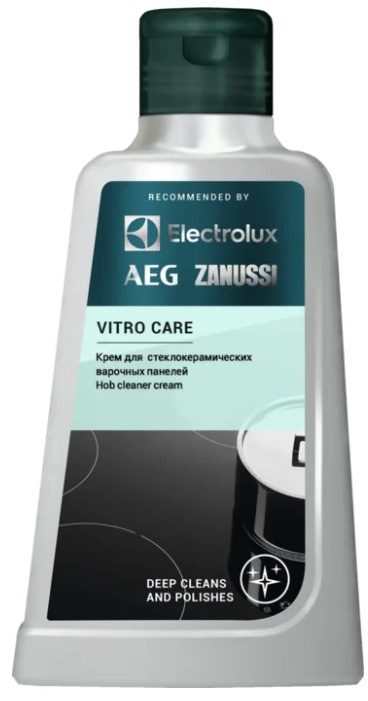
And this is our winner! An excellent tool that not only cleans the contaminated surface, but also "carries out preventive work." Vitro care is made with silicone, which, after rinsing off the product, lays down in a thin layer and subsequently protects the surface from stubborn dirt.
The quality of an Electrolux cleaning product can be judged not only by official tests carried out by the manufacturer, but also by numerous enthusiastic customer reviews.
Benefits:
- Cleans perfectly even without a scraper or other aids;
- Convenient cover;
- Liquid consistency ensures economical consumption;
- Creates a protective film;
- Leaves no streaks;
- Polishes;
- Lasts for a long time, despite the volume of 250 ml.
Disadvantages:
- Price;
- Specific smell.
Another small drawback is the fact that Vitro care is often not available in large stores. Here, of course, there are more claims to them than to chemistry, but still this is something worth paying attention to.
Output:
Vitro Care won a well-deserved victory. Some, of course, are confused by how much the product costs. However, we understand that quality comes at a price. And therefore, the sure answer to the question "which cleaner is better to buy for the hob" will be Electrolux Virta care.
Moreover, it shows an excellent result in the form of a clean glass-ceramic hob surface.
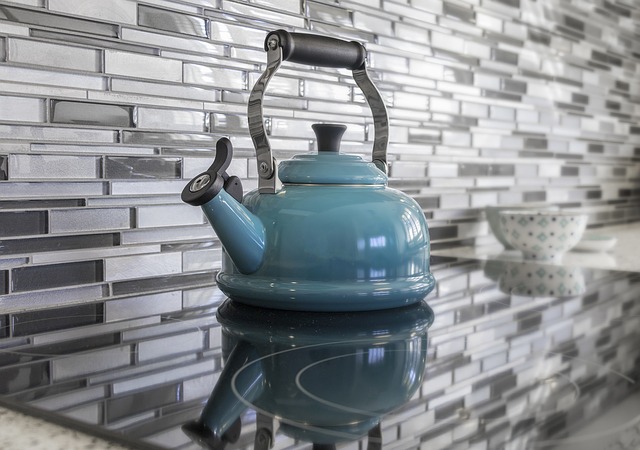
Most of the funds from the top three are very similar to each other. And which company is better to choose is an individual matter. The big advantage of the top three is that they do not contain plastic abrasives that pollute the environment. Do you agree with this rating? Share your experience in the comments.













